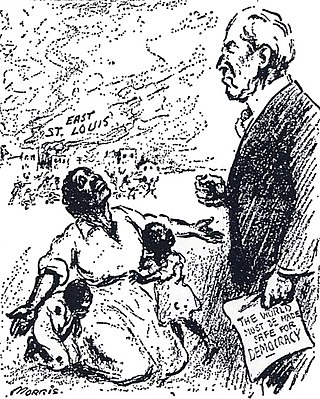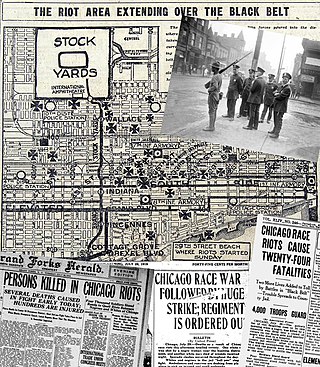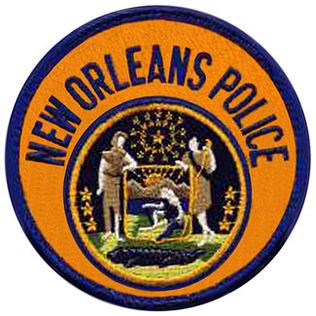Related Research Articles
In the broader context of racism in the United States, mass racial violence in the United States consists of ethnic conflicts and race riots, along with such events as:

The Aryan Brotherhood is a neo-Nazi prison gang and an organized crime syndicate that is based in the United States and has an estimated 15,000–20,000 members both inside and outside prisons. The Southern Poverty Law Center (SPLC) has characterized it as "the nation's oldest major white supremacist prison gang and a national crime syndicate" while the Anti-Defamation League calls it the "oldest and most notorious racist prison gang in the United States". According to the Federal Bureau of Investigation (FBI), the Aryan Brotherhood makes up an extremely low percentage of the entire US prison population, but it is responsible for a disproportionately large number of prison murders.

York is a city in and the county seat of York County, Pennsylvania, United States. Located in South Central Pennsylvania, the city's population was 44,800 at the time of the 2020 census, making it the tenth-most populous city in Pennsylvania. The city has an urban area population of 238,549 people and a metropolitan population of 456,438 people.
Murder, Inc. was an organized crime group active from 1929 to 1941 that acted as the enforcement arm of the National Crime Syndicate – a closely connected criminal organization that included Italian-American Mafia, the Jewish Mob, and other criminal organizations in New York City and elsewhere. Murder, Inc. was composed of Jewish and Italian-American gangsters, and members were mainly recruited from poor and working-class Jewish and Italian neighborhoods in Manhattan and Brooklyn. It was initially headed by Louis "Lepke" Buchalter and later by Albert "Mad Hatter" Anastasia.

The Red Summer was a period in mid-1919 during which white supremacist terrorism and racial riots occurred in more than three dozen cities across the United States, and in one rural county in Arkansas. The term "Red Summer" was coined by civil rights activist and author James Weldon Johnson, who had been employed as a field secretary by the National Association for the Advancement of Colored People (NAACP) since 1916. In 1919, he organized peaceful protests against the racial violence.

The East St. Louis massacre was a series of violent attacks between African Americans and white Americans in East St. Louis, Illinois, between late May and early July of 1917. These attacks also displaced 6,000 African Americans and led to the destruction of approximately $400,000 worth of property. They occurred in East St. Louis, an industrial city on the east bank of the Mississippi River, directly opposite the city of St. Louis, Missouri. The July 1917 episode in particular was marked by violence throughout the city. The multi-day rioting has been described as the "worst case of labor-related violence in 20th-century American history", and among the worst racial riots in U.S. history.
In modern politics, "law and order" is an ideological approach focusing on harsher enforcement and penalties as ways to reduce crime. Penalties for perpetrators of disorder may include longer terms of imprisonment, mandatory sentencing, three-strikes laws and even capital punishment in some countries. Supporters of "law and order" argue that harsh punishment is the most effective means of crime prevention. Opponents argue that a system of harsh criminal punishment is ultimately ineffective because it self-perpetuates crime and does not address underlying or systemic causes of crime. They furthermore credit it with facilitating greater militarisation of police and contributing to mass incarceration in the United States.
Crime rates in New York City have been recorded since at least the 1800s. The highest crime totals were recorded in the late 1980s and early 1990s as the crack epidemic surged, and then declined continuously from around 1990 throughout the 2000s. As of 2023, New York City has significantly lower rates of gun violence than many other large cities. Its 2022 homicide rate of 5.3 per 100,000 residents compares favorably to the rate in the United States as a whole and to rates in much more violent cities such as New Orleans and St. Louis.
About one to two percent of United States Armed Forces members are estimated to belong to criminal gangs in the United States, a much higher proportion than in the civilian population.
Michael Griffith was a 23-year-old black man who was killed on December 20, 1986, in Howard Beach, in Queens, New York City, in a racially motivated attack. Griffith and two other black men were set upon by a group of white youths outside a pizza parlor. Two of the victims, including Griffith, were severely beaten. Griffith fled onto a highway where he was fatally struck by a passing motorist.

The 1943Detroit race riot took place in Detroit, Michigan, from the evening of June 20 through to the early morning of June 22. It occurred in a period of dramatic population increase and social tensions associated with the military buildup of U.S. participation in World War II, as Detroit's automotive industry was converted to the war effort. Existing social tensions and housing shortages were exacerbated by racist feelings about the arrival of nearly 400,000 migrants, both African-American and White Southerners, from the Southeastern United States between 1941 and 1943. The migrants competed for space and jobs against the city's residents as well as against European immigrants and their descendants. The riot escalated after a false rumor spread that a mob of whites had thrown a black mother and her baby into the Detroit River. Blacks looted and destroyed white property as retaliation. Whites overran Woodward to Veron where they proceeded to violently attack black community members and tip over 20 cars that belonged to black families.
The Notting Hill race riots were a series of racially motivated riots that took place in Notting Hill, a district of London, between 29 August and 5 September 1958.

The Chicago race riot of 1919 was a violent racial conflict between white Americans and black Americans that began on the South Side of Chicago, Illinois, on July 27 and ended on August 3, 1919. During the riot, 38 people died. Over the week, injuries attributed to the episodic confrontations stood at 537, two-thirds black and one-third white; and between 1,000 and 2,000 residents, most of them black, lost their homes. Due to its sustained violence and widespread economic impact, it is considered the worst of the scores of riots and civil disturbances across the United States during the "Red Summer" of 1919, so named because of its racial and labor violence. It was also one of the worst riots in the history of Illinois.

The New Orleans Police Department (NOPD) has primary responsibility for law enforcement in New Orleans, Louisiana, United States. The department's jurisdiction covers all of Orleans Parish, while the city itself is divided into eight police districts.
Crime in Omaha, Nebraska has varied widely, ranging from Omaha's early years as a frontier town with typically widespread gambling and prostitution, to civic expectation of higher standards as the city grew, and contemporary concerns about violent crimes related to gangs and dysfunctions of persistent unemployment, poverty and lack of education among some residents.
Philadelphia consistently ranks above the national average in terms of crime, especially violent offenses. It has the highest violent crime rate of the Top 10 American cities with a population greater than 1 million residents as well as the highest poverty rate among these cities. It has been included in real estate analytics company NeighborhoodScout's "Top 100 Most Dangerous Cities in America" list every year since it has been compiled. Much of the crime is concentrated in the North, West, and Southwest sections of the city. The deadliest year in Philadelphia was 2021 with 562 murders.
Charles H. Robertson was an American Democratic politician who served as mayor of York, Pennsylvania from 1994 to January 2002. In May 2001, Robertson was charged for a murder during the York race riots in July 1969, but was acquitted in October 2002.
Christopher Alaneme was a British murder victim. He was eighteen years old when he was murdered on 21 April 2006 in Sheerness, Kent, England. The convicted killer is Peter Connolly, who was a painter and decorator of Carisbrooke Gardens, Peckham.

The relationship between race and capital punishment in the United States has been studied extensively. As of 2014, 42 percent of those on death row in the United States were Black. As of October 2002, there were 12 executions of White defendants where the murder victim was Black, however, there were 178 executed defendants who were Black with a White murder victim. Since then, the number of white defendants executed where the murder victim was black has increased to just 21, whereas the number of Black defendants executed where the murder victim was White has increased to 299. 54 percent of people wrongfully convicted and sentenced to death in the United States are black.
References
- ↑ Zarefsky, David. President Johnson's War on Poverty: Rhetoric and History , pp. 111-118. University, Alabama: The University of Alabama Press, 1986.
- ↑ Peter J. Ling, "What a difference a death makes: JFK, LBJ, and the Civil Rights Act of 1964." The Sixties 8#2 (2015): 121–137.
- ↑ "Cities Find Riot Insurance Dear, Hard to Get." York, Pennsylvania: The York Dispatch, August 15, 1969, p. 5 (subscription required).
- ↑ McKee, Don. "Double Trouble: The Economics of Racism." York, Pennsylvania: The Gazette and Daily, June 29, 1963, p. 19 (subscription required).
- ↑ "Mass Meeting on York Racial Problems Slated." York, Pennsylvania: The Gazette and Daily, September 26, 1963, front page (subscription required).
- ↑ "United Church Unit in Move Against Racial Bias." York, Pennsylvania: The York Dispatch, September 20, 1963, p. 14 (subscription required).
- ↑ "Mayor, Action Team Weigh Next Efforts: Snyder Considers Bi-Racial Group, Rejects Police Review Board." York, Pennsylvania: The York Dispatch, August 14, 1963, p. 24 (subscription required).
- ↑ Strong, Kim (April 19, 2016). "Silent no more: The murder of Lillie Belle Allen". York Daily Record. Retrieved July 23, 2016.
- ↑ "FROM THE ARCHIVES: New leads in '69 slayings". York Dispatch. Retrieved 2023-08-12.
- ↑ Worden, Amy (October 20, 2002). "York Ex-Mayor Acquitted Two men are convicted in the 1969 race-riot slaying of S.C. woman". The Philadelphia Inquirer . Archived from the original on November 12, 2014. Retrieved July 23, 2017.
- ↑ "2 Men Are Sentenced for Killing of Woman in 1969 Race Riot". The New York Times . Associated Press. December 19, 2002. Retrieved July 23, 2017.
- ↑ "10th defendant sentenced in Aiken woman's 1969 race-riot killing 052903". The Augusta Chronicle . Associated Press. May 29, 2003. Archived from the original on March 4, 2016. Retrieved July 23, 2017.
- ↑ "1969 York race riots: Timeline of criminal cases". York Daily Record. Retrieved 2023-08-12.